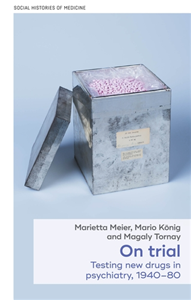Your Search Results
-
The Royal College of Psychiatrists
Royal College of Psychiatrists publish a wide range of books on mental health for both psychiatrists and the general public, along withtheir flagship journal the British Journal of Psychiatry.
View Rights Portal
-
Promoted ContentMedicine
Clinical Handbook of Psychotropic Drugs
by Ric M. Procyshyn, Kalyna Z. Bezchlibnyk-Butler, David D. Kim (Eds.)
Quick and comprehensive information on psychotropic drugs for adults. The “Clinical Handbook of Psychotropic Drugs” has become a standard reference and working tool for psychiatrists, psychologists, physicians, pharmacists, nurses, and other mental health professionals Independent, unbiased, uptodate Packed with unique, easy-to-read comparison charts and tables (dosages, side effects, pharmacokinetics, interactions …) for a quick overview of treatment options Succinct, bulleted information on all classes of medication: on- and off-label indications, (US FDA, Health Canada), recommended dosages, US and Canadian trade names, side effects, interactions, pharmacodynamics, precautions in the young, the elderly, and pregnancy, nursing implications, and much more – all you need to know for each class of drug Potential interactions and side effects summarized in comparison charts With instantly recognizable icons and in full color throughout, allowing you to fnd at a glance all the information you seek Clearly written patient information sheets available for download as printable PDF files
-
Promoted ContentHealth & Personal Development
Clinical Handbook of Psychotropic Drugs for Children and Adolescents
by Dean Elbe, Kalyna Z. Bezchlibnyk-Butler, Adil S. Virani
Quick and comprehensive information on psychotropic drugs for children and adolescents. The “Clinical Handbook of Psychotropic Drugs for Children and Adolescents” is a unique resource to help you make the right choices about psychotropic medications for younger patients. The ffth edition of this widely acclaimed reference has been fully updated and expanded. • Updated information on psychiatric disorders in children and adolescents • U nique comparison charts (dosages, side effects, pharmacokinetics, interactions …) that allow you to see at a glance which medication is the most suitable for each patient • Instantly recognizable icons in full color throughout, a llowing you to quickly fnd all the information you seek • G eneral information on medications, availability, and indications • D rug action, dosing, pharmacokinetics, and related areas• Warnings and precautions • P atientrelated information, such as lab monitoring recommendations, nursing implications, and patient advice• Clearly written patient and caregiver information sheets as printable PDF fles
-
 Trusted Partner
2021
Trusted Partner
2021Psychotropic Drugs in General Practice
How to recognise, understand and treat patients successfully
by PD Dr. Daniel Schüpbach and Dr. Otto Dietmaier
The purpose of this book is to support general practitioners in finding the optimum, guideline-compliant therapy for their patients. The focus is on the clinical pictures of depression, psychosis as well as anxiety and sleep disorders and the handling of psychiatric emergencies. The reader will learn everything about the epidemiology, aetiology, diagnosis and medical treatment of these diseases, about switching therapy and about treatment in pregnancy and lactation. All the available psychotropic drugs and their pharmacological properties are described in detail – including key specific features of active substances and drug safety aspects. The table of substances in the appendix provides a clear summary of the information and simplifies the choice of the appropriate drug. The extras: - 13 factsheets with concise, summarised information to cope with tricky situations in the practice - The authors take the current treatment guidelines from Germany, Austria and Switzerland into account and name examples of proprietary medicinal products in the three countries.
-
 Trusted Partner
Humanities & Social Sciences
Trusted Partner
Humanities & Social SciencesClinical Handbook of Psychotropic Drugs
by Ric M. Procyshyn / Kalyna Z. Bezchlibnyk-Butler / J. Joel Jeffries (Eds.)
The “Clinical Handbook of Psychotropic Drugs” has become a standard reference and working tool for psychiatrists, psychologists, physicians, pharmacists, nurses, and other mental health professionals.• Independent, unbiased, up-to-date• Packed with unique, easy-to-read comparison charts andtables (dosages, side effects, pharmacokinetics, interactions…)for a quick overview of treatment options• Succinct, bulleted information on all classes of medication:on- and off-label indications, (US FDA, Health Canada),recommended dosages, US and Canadian trade names, sideeffects, interactions, pharmacodynamics, precautions inthe young, the elderly, and pregnancy, nursing implications,and much more – all you need to know for each class of drug• Potential interactions and side effects summarized incomparison charts• With instantly recognizable icons and in full color throughout,allowing you to find at a glance all the information you seek• Clearly written patient information sheets available fordownload as printable PDF files This book is a must for everyone who needs an up-to-date, easyto- use, comprehensive summary of all the most relevant information about psychotropic drugs. Tables, graphs, and overviews make this handbook a practical tool for professionals. For:• psychiatrists und psychologists• physicians and pharmacists• nurses, and other mental health
-
 Trusted Partner
January 2025
Trusted Partner
January 2025Psychotropic Drugs
Training for nursing staff
by Dr. C. Schäfer
Psychotropic drugs in the elderly carry significant risks of dangerous side effects, such as cognitive impairment, falls and confusion, and their use requires careful evaluation of the patient‘s condition and concurrent medications. Nursing staff have the best insight here and play a key role in identi- fying and preventing sometimes serious side effects. This training equips nurses with the basic knowledge they need! Concise, care-focused content featuring key information on common mental illnesses in old age and their treatments. The content covers delirium, unipolar and bipolar depres- sion, schizophrenia, sleep disorders, Parkinson‘s disease, dementia and epilepsy. Nursing staff should be familiar with typical symptoms and commonly used medications, as understanding side effects and interactions can save lives. The content of the second edition has been updated to reflect current therapeutic guidelines and the latest scientific findings. Now available with a practical brochure (replacing the CD). It includes lecture texts for the 37 training slides. The PowerPoint presentation can be downloaded from www.Online-PlusBase.de. If needed, it can be customised by the lecturer or home care pharmacy to meet the specific needs of the corresponding nursing facility. A colour-coded system on the slides offers guidance through the drug groups. Target group: Pharmacists, pharmacies supplying nursing homes, physicians, nursing management
-
 Trusted Partner
2021
Trusted Partner
2021Psychopharmacology and Psychopharmacotherapy.A Concise Guide
Training curriculum for medical specialists in psychiatry and psychotherapy
by Edited by Prof. Dr. Dipl.-Psych. Gerd Laux and Prof. Dr. Walter E. Müller
Psychotropic drugs have established their place in mental illnesses and form an important element of treatment. This textbook guides the selection of pharmacotherapy for a variety of psychological disorders such as depression, schizophrenia or dementia. The reader will learn, - How to use the various drugs in a targeted manner - The mechanisms of action on which they are based - Why side effects occur and how they can be dealt with. This book corresponds to the curriculum for the training of medical specialists in psychiatry and psychotherapy. It is an indispensable aid to anyone who uses psychotropic drugs!
-
 Trusted Partner
MedicineJanuary 2026
Trusted Partner
MedicineJanuary 2026On trial
Testing new drugs in psychiatry, 1940–1980
by Marietta Meier, Mario König, Magaly Tornay
The heroic story of the invention of antidepressants is a key part of the psychopharmaceutical turn. On Trial revolves around one of its pioneers, psychiatrist Roland Kuhn, who practiced in Münsterlingen, a state-run psychiatric hospital in Switzerland. Kuhn became famous for the 'discovery' of the first antidepressant, Tofranil, and more recently notorious for his numerous trials on often unsuspecting patients. Largely based on the extensive and previously inaccessible sources of Kuhn's private archive, the book delves into the early days of industry-sponsored clinical research in psychiatry. It examines how the clinic, patients, doctors, nursing staff, corporations, and authorities interacted in the trials. Conducted from the 1940s to 1980s, the Münsterlingen drug trials are historicised and situated in the period's evolving landscape of experimentation.
-
 Trusted Partner
MedicineJuly 2024
Trusted Partner
MedicineJuly 2024On trial
Testing new drugs in psychiatry, 1940–1980
by Marietta Meier, Magaly Tornay, Mario König
The heroic story of the invention of antidepressants is a key part of the psychopharmaceutical turn. On Trial revolves around one of its pioneers, psychiatrist Roland Kuhn, who practiced in Münsterlingen, a state-run psychiatric hospital in Switzerland. Kuhn became famous for the 'discovery' of the first antidepressant, Tofranil, and more recently notorious for his numerous trials on often unsuspecting patients. Largely based on the extensive and previously inaccessible sources of Kuhn's private archive, the book delves into the early days of industry-sponsored clinical research in psychiatry. It examines how the clinic, patients, doctors, nursing staff, corporations, and authorities interacted in the trials. Conducted from the 1940s to 1980s, the Münsterlingen drug trials are historicised and situated in the period's evolving landscape of experimentation.
-
 Trusted Partner
2024
Trusted Partner
2024Intoxicating Drugs
Known and new psychoactive substances
by Prof. Dr. Niels Eckstein
Intoxicating? Intoxicating drugs are as old as mankind itself. Whether herbal or produced synthetically in a laboratory, their variety is almost limitless. And every year, more substances are added to the list. Niels Eckstein, who is a Professor of Drug Regulatory Affairs and Pharmacology and a long-standing expert in the narcotics scene, explores the abysses of the darknet and dealer hell, provides insider information, conducts interviews with dealers and producers, and offers profound insights into the bizarre, parallel world of intoxicating substances. At the same time, the author takes a thorough look at the chemistry of the different substance classes and the neurobiological basis of addiction. He also covers production and assesses the danger and addiction potential of designer drugs, BTM, NPS, medicinal drugs and doping substances. This book outlines the political and sociopolitical dimensions of the use of psychoactive substances, classifies them legally, describes risks, approaches, and help strategies, highlights routes out of drug problems and alternatives to drug prohibition, and comments on the opioid crisis in the United States and the „war on drugs.“ “I don‘t care how it‘s regulated: if he wants it and can pay for it, he gets it. If I get caught, I‘ll go to jail for a few years, whether it‘s for a kilo of coke, meph or testo, it doesn‘t matter.“ – In an interview with a dealer
-
 Trusted Partner
April 2022
Trusted Partner
April 2022Fritz, the Gorilla
Biography of a Fascinating Ape
by Jenny von Sperber
When Jenny von Sperber first met Fritz, the gorilla didn’t let her out of his sight. He was already over 50 years old then, but he was still extremely charismatic. One thing matters for the journalist: she wants to find out everything about Fritz’s life. Born in 1963, he was captured in the wild and came from Cameroon to Germany in 1966. At that time, apes were still regarded as a curiosity in zoos. When a ban was declared on the wild gorilla trade, Fritz was already a father of many youngsters. This fascinating gorilla-family saga not only recounts the eventful life of Fritz, but also shows the development in European zoos in handling wild animals. Nowadays, things have certainly improved. But there are still questions, for example, what does it do to us when we marvel at our closest relatives behind glass? And is it even still current to confine apes ... was it ever?


















